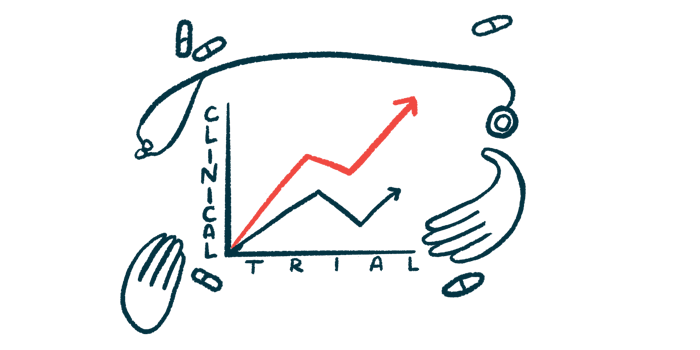DYNE-101 is leading to functional gains for DM1 patients in trial
Data from new participant set could support accelerated approval request

The investigational therapy DYNE-101 worked as expected and led to functional improvements for people with myotonic dystrophy type 1 (DM1) in a clinical trial, according to an update from developer Dyne Therapeutics.
The Phase 1/2 ACHIEVE trial (NCT05481879) will now enroll a new group of participants who will all receive the dose that’s so far shown the most promising clinical benefit. Data from this group — called the registrational expansion cohort — could support a request for accelerated approval of DYNE-101 for DM1 in the U.S. Dyne is also pursuing expedited approval pathways in other countries.
“The data from the ACHIEVE trial in DM1 show substantial functional benefit across a range of clinical measures and we are excited to have selected the dose for our registrational expansion cohort,” Doug Kerr, MD, PhD, chief medical officer of Dyne, said in a company press release. “Supported by our robust results, we are advancing the development of DYNE-101 rapidly, recognizing the urgency to bring the potential first treatment to people living with DM1.”
Another Phase 1/2 trial called DELIVER (NCT05524883) is testing investigational therapy DYNE-251 in boys, ages 4-16, with Duchenne muscular dystrophy (DMD). That study is also enrolling a registrational expansion cohort that’s expected to support regulatory applications.
“With both programs, we remain on track to complete enrollment in our registrational expansion cohorts in 2025 with the goal to submit applications for accelerated approvals in 2026 in hopes of transforming the treatment paradigm for patients,” said John Cox, president and CEO of Dyne.
DM1 is a form of muscular dystrophy where mutations in the DMPK gene lead to the production of an abnormal version of RNA, a template molecule used to make protein. This abnormal RNA accumulates and disturbs the proper production of proteins important for muscle health, and particularly interferes with a process called splicing, which helps process RNA molecules for protein production
Testing DYNE-101
DYNE-101 contains oligonucleotides, or short strands of genetic material that can influence gene activity, that are designed to bind to these DMPK RNA clumps and cause them to be degraded. The oligonucleotides are bound to antibodies that direct them specifically to muscle cells.
ACHIEVE is testing various into-the-vein dosing regimens of DYNE-101 against a placebo in adults with DM1, ages 18-49.
Previous interim data from multiple dosing groups suggested DYNE-101 was working as intended to correct splicing defects, ease myotonia, which is a hallmark DM1 symptom marked by difficulty relaxing muscles, and improve other aspects of physical function.
The recent update concerned eight patients who received DYNE-101 at 6.8 mg/kg once every other month, which is the regimen Dyne has selected for the registrational expansion cohort.
The treatment led to a substantial reduction in DMPK RNA along with splicing defect corrections, as measured by the composite alternative splicing index (CASI-22), after three months. It was also associated with reductions in myotonia and functional improvements in measures of muscle strength, balance, and fatigue that were observed as early as three months and sustained up to six months.
Favorable trends were observed in patient-reported outcome measures of disease burden, including subscales related to brain and spinal cord health.
Across dosing groups, DYNE-101 has been well tolerated, with no serious treatment-related adverse events identified.
A ‘significant step forward’ for DM1
Dyne has communicated with the FDA about pursuing DYNE-101’s accelerated approval, which conditionally allows a treatment to be marketed based on preliminary evidence that it’s likely to be effective while confirmatory clinical trials are ongoing. Accelerated approval relies on what’s called a surrogate clinical trial endpoint, one that predicts a treatment’s clinical benefit, but isn’t directly measuring it. In the case of DYNE-101, the company plans to use CASI-22 as its surrogate endpoint.
The registrational expansion cohort will include about 32 patients who will receive the 6.8 mg/kg dosing regimen. The primary endpoint in this group will be CASI-22, with functional measures also collected.
“The ACHIEVE trial data represent a significant step forward and underscore the potential of DYNE-101 to address many of the most challenging symptoms experienced by individuals living with DM1,” said James Lilleker, PhD, a neurologist and principal investigator of ACHIEVE.
DYNE-251, designed with the same platform as DYNE-101, is intended to boost production of dystrophin, the muscle protein people with DMD lack, for patients with disease-causing mutations in the DMD gene amenable to exon 51 skipping.
Dyne previously reported DELIVER trial data that showed the therapy led to increases in dystrophin levels and functional improvements. Since that update, it’s reported the treatment remains well tolerated without any new treatment-related serious adverse events.
The company is pursuing accelerated approval of DYNE-251 using dystrophin levels as a surrogate endpoint.







